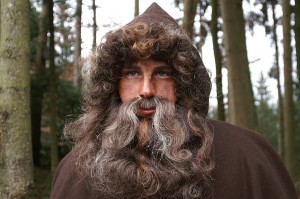Sarah recently wrote about our town and the approaching holidays, including an interaction between our children and Switzerland’s beloved Samichlaus. If you are anything like me, though, you may have eyed the darkly-clad mysterious figure next to Samichlaus and thought to yourself, “Who in the name of Yukon Cornelius is this baffling Christmas character?” It turns out that while America has imported and adapted the figure of Santa Claus for our Christmas season, we have largely abandoned the concept of his “Companions” that is so prevalent throughout Europe.

The mysterious dark figure that accompanies Samichlaus is none other than Schmutzli (or Père Fouettard in the French speaking regions), and he is Father Christmas’ answer to Corporal Punishment. Or at least, he used to be. While it was Samichlaus who loved children and brought them gifts of candy, nuts, and mandarins, Schmutzli was known to punish the naughty children by whipping them with a switch from his broom. His relationship to Samichlaus is not really well understood, but now he has become a more benevolent helper, passing out candy, nuts, and mandarins to children who recite poems or sing songs.
While Santa Claus lives in the North Pole, Samichlaus and Schmutzli live together in a hut (with a presumably Platonic relationship) in Germany’s Black Forest. One story I have heard is that Schmutzli was a poor woodcutter who “saved Christmas” one year. Samichlaus’ bag of treats had ripped open, and Schmutzli walked around with his own sack gathering up the fallen treats. Samichlaus was so grateful when Schmutzli brought him back all of the treats that he invited Schmutzli to accompany him on his journey to children’s houses. How, or when, it was decided that Schmutzli would get to beat the bad children (or stuff them in his sack), is less clear.
While the name Schmutzli uniquely belongs to Switzerland, European versions of St. Nick have traveled with other, similar Companions for centuries. He goes by many names and faces: Knecht Ruprecht (Rupert the Farmhand), Zwarte Piet (Black Peter), Krampus, Belsnickel, Bellzebub, and more. They all seem to have the same philosophy in common: they bring fear and retribution along with the kindness of St. Nick. They are the negative reinforcement to Santa’s positive reinforcement. (NPR recently did a story about the Krampus from the European Alpine folklore, if you are interested.)

Samichlaus and Schmutzli have their big night on December 6th, when they make the rounds visiting houses and leaving treats. On December 25th, however, presents are left for children by the Christkind or Christ child. Similar to our Santa Claus, the Christkind won’t leave presents while children are still awake (or at least not while they are in the room). Kids are sent to bed, or to hide in the basement while the Christkind leaves presents, and then the children are summoned back to the main room in hopes that they will get a glimpse of the Christkind before he flies out the door. Alas, he is still rarely seen.
David Sedaris summed up his reaction to the Dutch Christmas story, and how it contrasted with our American story, nicely (for full text, read the entire piece in Esquire here, or hear David Sedaris read it here – it is well worth the 15 minutes):
While eight flying reindeer are a hard pill to swallow, our Christmas story remains relatively simple. Santa lives with his wife in a remote polar village and spends one night a year traveling around the world. If you’re bad, he leaves you coal. If you’re good and live in America, he’ll give you just about anything you want. We tell our children to be good and send them off to bed, where they lie awake, anticipating their great bounty. A Dutch parent has a decidedly hairier story to relate, telling his children, “Listen, you might want to pack a few of your things together before you go to bed. The former bishop from Turkey will be coming along with six to eight black men. They might put some candy in your shoes, they might stuff you in a sack and take you to Spain, or they might just pretend to kick you. We don’t know for sure, but we want you to be prepared.”

Joe, Interesting and a little intimidating. I prefer our Santa Claus and our Elf on the Shelf approach. Love Mom